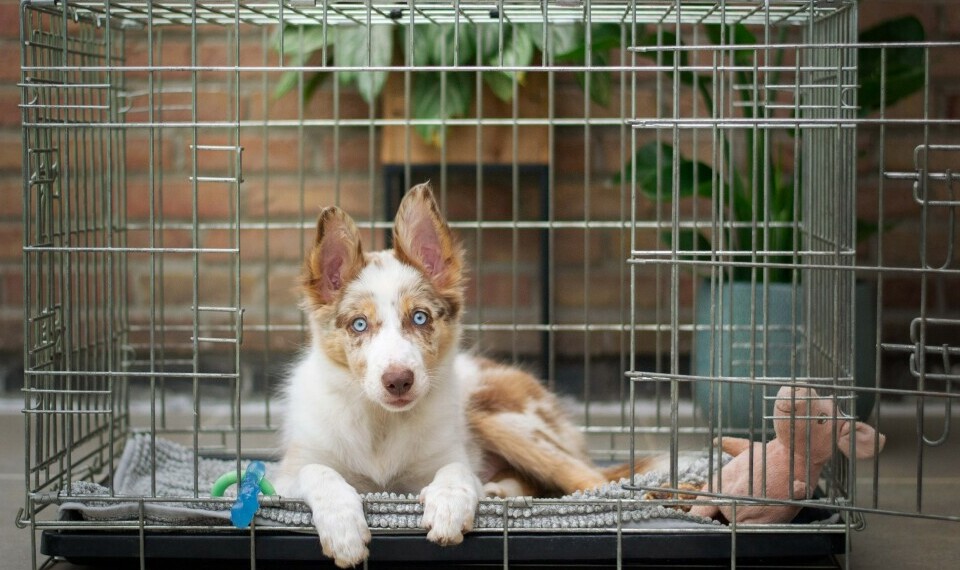
What is crate training? We’re going to break down what crate training really is and why it may be beneficial to your dog. Think of crate training as providing your dog with a room of their own. It’s a personal space for them to retreat to, feel secure, and call their own. Just as your bedroom is your sanctuary, a crate is designed to be a safe, comfortable, and cozy space for your dog.
You might be wondering how this technique came about. Well, crate training has roots that reach back to the time when dogs were wild and sought refuge in small dens. This natural instinct for a secure hideaway has been adapted into modern training practices, aiming to replicate that sense of a secure den.
If you’re worried that it seems like a punishment, don’t be. This isn’t just about confining a pet; it’s also about providing a sense of routine and territory that can help them feel balanced and happy. Training your furry friend correctly ensures the crate feels like a haven, not a jail. This should be emphasized, as a dog should want to be in their safe place, and if it’s made out to be a place that they are confined to when they are being bad, it will be looked upon more as a cell than a private room.
With our guidance, you’re going to find out about the humane and effective ways to crate train and how to make it a positive experience for your companion. Implementing this method can make a vast difference for both you and your pet, building a foundation for solid behavioral practices.
Looking for fresh dog food delivered? Click here.

Unpacking the Benefits: Why Crate Training Matters
You’re going to find out about crate training’s positive impact on both pets and their owners. It’s not just about convenience; it’s also about providing a special space for your furry friend. Animals, much like humans, appreciate having a spot they can call their own. Crate training taps into a dog’s natural instinct for a den-like enclosure, offering a sense of security and privacy. This can be especially comforting for a new puppy adjusting to their home, or for an older dog seeking solitude. Their crate can provide a private escape for whenever their outside environment makes them anxious.
In terms of practical advantages, crate training is a key player in housebreaking. Young dogs can learn to hold their bladder while they’re in their crate, as they don’t like to soil their sleeping area. This principle helps accelerate potty training and maintains cleanliness in your home. Also, it’s important to remember that crate training should be a positive experience. Associating the crate with good feelings aids in this learning process. Make sure your pup feels happy and comfortable when around their crate.
Click here for our top picks for the best training treats for dogs.
Regarding behavior, think of crates as a tool for instilling discipline. They can help curb destructive tendencies by providing a controlled environment when supervision isn’t possible. You want to enjoy coming home without finding chewed-up shoes or a toppled trash can. Crate training can help with that. Moreover, for dogs that experience anxiety, a crate can be a safe retreat during stressful events like thunderstorms or parties. It’s important to reiterate however that while doing this one should not make the puppy look at their crate as a negative space and that they are being locked up. The crates should only be used to reinforce good behaviors.
Now, let’s look a little closer at the benefits of crate training your pooch and see how they stack up against some people’s concerns about the method. This leads us into a comparison with other training methods and helps us gauge whether crate training really is the best approach among many.

Comparing Canine Training Methods: Is Crate Training Supreme?
When you’re looking into training your furry friend, you’re going to find out about a variety of methods. It’s not a one-size-fits-all scenario. Let’s discuss the **landscape of canine training** and see where crate training fits in.
Traditional housebreaking, obedience classes, positive reinforcement, clicker training, and electronic training are just a few of the paths you can wander down when looking for a way to teach your dog. Each strategy offers different benefits, and what works for one dog might not work for another.
Crate training is unique because it taps into a dog’s instinctive desire for a den-like space. Yet, some folks might feel uneasy about it, concerned that it looks like a mini jail. We’re here to help you with that concern by ensuring you understand proper crate training emphasizes a positive, safe environment, not punishment.
Click here for our top picks for the best training treats for dogs.
Incorporating a crate in your training strategy effectively can provide structure and a sense of security. But is it the best way to train? Well, there’s two ways to react to this. Some would argue that it depends on the individual pet’s personality and needs, while others swear by it as the cornerstone of a well-rounded training approach. We shoot for the latter. We feel it can be used along with other training methods, not instead of them.
In our opinion, crate training, done correctly, isn’t just ‘one’ training method among many—it’s a valuable tool in a larger toolkit. While it excels with housebreaking and behavior molding, it should be paired with other forms of training to foster a well-adjusted and obedient canine companion. Crate training is just one part of training your puppy and other training should be used as well to make a well rounded pup.
Your first attempt doesn’t need to be your last. If crate training is part of your approach, observe your dog’s response. You can always adjust your methods down the road. Be patient with them and make sure to keep training sessions fun and positive but productive. The goal is a happy, healthy, and well-behaved pup. That’s the strategy we like to leverage.

Opening the Door to Success: Advantages of Crate Training
We hope you’re now seeing the great opportunity that crate training offers both you and your furry friend. It’s more than just a training tool; it’s a pathway to a well-adjusted pet. Once they master their crate behavior, it will be completely natural to them and won’t even be a thought.
Let’s discuss travel. If you’re someone who loves to take your dog on adventures, crate training is invaluable. A crate-trained dog can handle trips much better, feeling secure in their familiar space. Air travel, hotel stays, and visits to friends or family or anywhere they might be confined to a small space. It’s seamless when your dog views their crate as a safe place.
In the face of emergencies, crate training really shows its worth. During times when quick action is needed, like natural disasters or unexpected home repairs, a dog that’s comfortable in a crate is one less worry. You can ensure they’re safe and not underfoot, allowing you to focus on the situation at hand. They will be comfortable and not anxious which can offer you peace of mind.
Crate training also offers everyday practicality. Have you ever worried about leaving your dog alone out of fear they might chew something they shouldn’t or have an accident? With a crate, these worries diminish. Plus, dogs actually enjoy the predictability of a regular routine which a crate can provide.
Your dog’s emotional well-being is a big part of your life, too. Crate training can significantly reduce separation anxiety and stress levels in dogs, which in turn, influences their overall health positively. Choose something that resonates with you, and for many, the security and scope of management that crate training provides is the perfect fit.
Remember, your first attempt at crate training doesn’t need to be your last. You can always adjust your approach down the road, finding the balance that works best for your pet’s personality and needs. Crate training isn’t about limitation; it’s about creating boundaries within which your dog can safely explore and rest.
In our humble opinion, embracing crate training is a choice that pays dividends in safety, convenience, and peace of mind. We really hope that you’ll consider the advantages and opportunities that crate training can provide for a happier, healthier life with your pet.
Looking for fresh dog food delivered? Click here.

